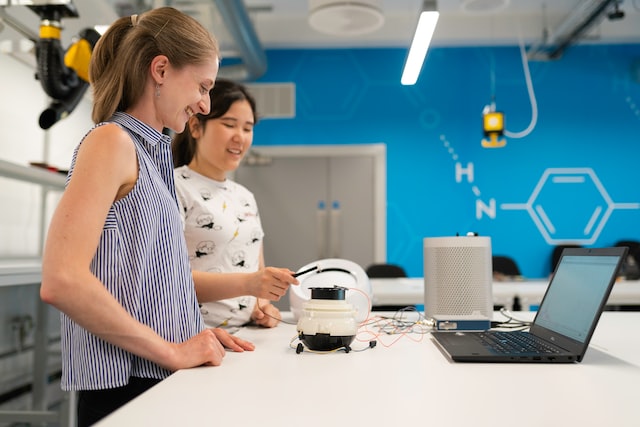ESG stands for Environmental, Social, and Governance. It’s a framework to assess an investment’s sustainability and societal impact on a company or organisation. The three factors of an ESG assessment can be summarised as:
- Environmental: The company’s ecological impact includes its carbon footprint, pollution levels, and resource consumption.
- Social: The company’s impact on society, such as its treatment of employees, customers, and communities, as well as its commitment to human rights and diversity.
- Governance: The company’s leadership and management, including its track record of transparency, accountability, and ethical behaviour.
Companies, investors, analysts, and rating agencies use ESG analyses to evaluate a company’s overall sustainability and potential for long-term growth and its exposure to environmental, social, and governance risks. Investors can better understand a company’s operations, risks, and opportunities by considering these three areas.
Benefits of ESG for big players in the IoT world

Before you think about how to use ESG, you should understand the benefits it has to offer your business. ESG offers several important benefits, particularly for established companies in the IoT world, including:
- Reputation: By incorporating ESG practices into their operations, IoT companies can improve their reputation and attract customers who are conscious of these issues. Certain brands, consumers, or potential partners will only work with companies that maintain a high reputation regarding these issues.
- Risk management: Compliance and governance regulations are becoming tighter and more complex across all industries, particularly regarding environmental impact and data privacy. Adopting ESG practices can help companies to identify and mitigate potential risks, such as regulatory fines and reputational damage.
- Cost savings: Implementing sustainable practices can help companies to reduce costs, for example, by reducing energy consumption and waste. Not to mention avoiding regulatory fines or financial losses due to reputational harm.
- Innovation: Emphasizing ESG can lead to the development of new products and services that address environmental and social issues. Many IoT companies aren’t aware of potential risks, hidden inefficiencies, or opportunities for improvement until they carry out this type of in-depth analysis.
- Long-term growth: Companies that prioritise ESG can position themselves for long-term growth by addressing future challenges related to environmental and social sustainability. This is particularly important in the current context of climate change and political instability.
Overall, IoT companies that incorporate ESG principles into their operations can benefit by reducing risk, increasing efficiency, and positioning themselves for long-term growth.
ESG and IoT – How IoT can help to achieve ESG goals

IoT benefits organisations, including streamlining operations, reducing costs, accelerating decision-making, improving customer experiences, and enhancing organization-wide visibility. In fact, you’re probably already at some stage on your own IoT adoption journey.
However, IoT can also help organisations achieve ESG goals in several ways:
- Energy efficiency: IoT sensors or devices can monitor and optimise energy usage in buildings and industrial facilities. This can help reduce energy utilisation, decrease greenhouse gas emissions and lower energy costs.
- Sustainable supply chain management: IoT can be used to track the transportation of goods and materials throughout the supply chain, providing transparency and visibility, as well as making it possible to analyse and predict the environmental impact of sourcing and fulfilling products.
- Environmental monitoring: IoT sensors can be used to collect data on environmental factors, like air and water quality, as well as soil conditions, which can help organisations identify and address environmental issues.
- Social responsibility: IoT devices monitor employees’ working conditions and ensure compliance with labour laws and human rights standards. Not to mention creating pleasant and productive working conditions for their employees.
In short, organisations can gain greater insights into their operations by leveraging IoT to make more informed decisions that align with ESG goals.
Examples of ESG initiatives in IoT
Organisations have already discovered a variety of useful applications for IoT to further their ESG standing. While there are too many applications to mention, here are some of the most impactful examples:
Smart building management

This typically involves various sensors deployed throughout a building to optimise its use. For example, to optimise energy usage, reduce water wastage, maintain comfortable (or required) temperature levels, monitor for fires or other hazards, onboard or guide employees, etc.
Recycling

IoT systems comprised of various sensors and RFID trackers can be used to sort and track waste materials. This can be used to promote efficient disposal and recycling with minimal environmental impact.
Transportation

The transportation sector has benefitted immensely from the deployment of IoT technology. It can monitor and track fleets, model and predict transportation times, and optimise schedules and routes or driver safety. As a result, this can boost efficiency, reduce emissions, and improve working conditions.
Challenges of ESG in IoT
Many of the traditional challenges involved with deploying and managing IoT devices carry over to using the technology for ESG. These include:
- Tracking and inventory management of the entire fleet of IoT devices, including managing their lifecycles.
- Carrying out maintenance of IoT devices, e.g., replacing batteries, testing device performance and validity of readings, replacing faulty sensors, cleaning, etc.
- Ensuring the proper infrastructure, e.g., energy and networking bandwidth, to utilise IoT fully.
- Addressing security and privacy concerns.
- Drafting and enforcing policies which ensure that IoT is being used in an ethically and socially responsible way and in line with internal governance and compliance practices.
- Ensuring the proper disposal or recycling of IoT devices at the end of their lifecycle.
Best practices for achieving ESG goals with IoT
As you can see, important factors are at play when implementing IoT for ESG beyond simply the technology and how to use it. You need to approach it correctly and maintain best practices throughout to ensure positive outcomes.

With that in mind, here are a few best practices for achieving ESG goals with IoT technology:
- Start by identifying the specific ESG goals you want to achieve, such as reducing carbon emissions, improving worker safety, or optimising operational expenditure.
- Collect IoT data to establish benchmarks and measure progress toward those goals. For example, you might use IoT sensors to monitor energy use in a building or track the location of employees in a factory.
- Use the data collected by IoT to identify areas where improvements can be made. For example, if you find that a particular piece of equipment consumes more energy than it should, you can improve its efficiency.
- Use IoT to automate processes to help you achieve your ESG goals. For example, you might use IoT-enabled equipment to shut down systems that are not used automatically or adjust lighting and heating levels based on occupancy.
- Continue to collect IoT data over time to measure overall improvements and calculate the impact of your ESG initiatives. Report and communicate these achievements to plan and promote IoT for ESG.
- Don’t view IoT or ESG as a once-off project. It’s a continuous and never-ending process of constant improvement. Continuously evaluate the performance of the technologies and governance structures used to achieve ESG goals.
- Focus on more than just quick wins and financial incentives. Ensure data privacy, security, and ethical considerations are always addressed and integrated.
- Collaborate with other companies, industry groups, and government agencies to share best practices and develop common standards for IoT and ESG. Many institutions are committed to the development and upholding of standards for both IoT and ESG across various industries.
The importance of ESG in IoT
As you continue your journey, you’ll discover that ESG is important for IoT and that IoT can be equally important for ESG. Combined, the two create a powerful framework for helping you bring your entire organisation in line with environmental, social, and governance-related issues that impact the future of your business.

We can reverse engineer the components of ESG to see how they impact various aspects of your IoT, such as:
- Environmental: The impact of your IoT systems on the environment, including energy consumption, sustainability, recyclability, etc.
- Social: Does the use of IoT positively or negatively impact your data privacy and security? Does it have any ethical implications? Is it used in a way that positively or negatively impacts the lives of the people it touches?
- Governance: Do you have the frameworks in place for the clear regulation of IoT devices and to maintain high operating standards?
Organisations must consider these factors during the design and implementation to ensure they permeate their IoT deployments. By letting ESG principles guide your implementation of IoT, you’ll not only reap the rewards for your business but use it to benefit society as a whole.
Manage Risk, Sustainability, and Growth
Environmental, societal, and governance-related concerns are increasingly important in managing risk, creating sustainable practices, and fostering long-term growth. A successful ESG strategy will also help a business manage its reputation, attract investors, and improve customer engagement.
The properties of IoT systems are uniquely suited to the task of helping organisations successfully reach ESG targets. However, at the same time, ESG principles should inform how you implement and utilise IoT systems, lest the cure becomes the poison.











